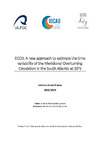Identificador persistente para citar o vincular este elemento:
https://accedacris.ulpgc.es/jspui/handle/10553/73577
| Campo DC | Valor | idioma |
|---|---|---|
| dc.contributor.advisor | Hernández Guerra, Alonso | es |
| dc.contributor.advisor | Casanova Masjoan, Maria | es |
| dc.contributor.author | Arumí Planas, Cristina | es |
| dc.date.accessioned | 2020-06-30T11:29:05Z | - |
| dc.date.available | 2020-06-30T11:29:05Z | - |
| dc.date.issued | 2019 | - |
| dc.identifier.uri | https://accedacris.ulpgc.es/handle/10553/73577 | - |
| dc.description.abstract | Time series of mass transport for the upper, deep and abyssal layers in the Atlantic Ocean at 30oS have been estimated using data obtained from the ECCOv4r3, a model developed by the Jet Propulsion Laboratory under a contract with the NASA. These estimations have been compared with analogous data obtained from the GO-SHIP hydrographic transoceanic sections at 30oS from 1993, 2003 and 2011. Results show that the ECCOv4r3 solution for the upper layers (γ#<27.58 kg/m3 ) is not significantly different from the mass transports estimated by the hydrographic data. This is not the case, however, for the deep and abyssal layers (γ#>27.58 kg/m3 ), where noticeable differences are found. The ECCOv4r3 points out that the Brazil Current shows a seasonal variability with higher mass transport from August to March (-15.8±0.7 Sv) than from April to July (-13.3±0.4 Sv). Furthermore, the ECCOv4r3 indicates that the Benguela Current shows a seasonal variability with higher mass transport from June to November (13.8±0.3 Sv) than from December to May (13.1±0.2 Sv). The comparison of heat transport and freshwater flux estimated with ECCOv4r3 to those obtained from hydrographic data show no significant differences. Nevertheless, the freshwater flux estimated by hydrographic data suggest that it has been decreasing during the study period, while the same estimation with ECCOv4r3 data do not show any decrease. The overturning stream-function estimated with ECCOv4r3 is not significantly different than the AMOC estimated by hydrographic data for the thermocline and intermediate layers. The ECCOv4r3 reveals that the AMOC shows a seasonal variability with stronger mass transport from April to September (16.6±0.9 Sv) than from October to March (14.5±0.2 Sv). | en_US |
| dc.language | eng | en_US |
| dc.subject | 251007 Oceanografía física | en_US |
| dc.subject.other | Circulación oceánica | es |
| dc.title | ECCO : a new approach to estimate the time variability of the Meridional Overturning Circulation in the South Atlantic at 30ºC | es |
| dc.type | info:eu-repo/semantics/bachelorThesis | en_US |
| dc.type | BachelorThesis | en_US |
| dc.contributor.centro | IU de Oceanografía y Cambio Global | en_US |
| dc.contributor.departamento | Departamento de Física | es |
| dc.contributor.facultad | Facultad de Ciencias del Mar | en_US |
| dc.investigacion | Ciencias | en_US |
| dc.type2 | Trabajo final de grado | en_US |
| dc.utils.revision | Sí | en_US |
| dc.identifier.matricula | TFT-51783 | es |
| dc.identifier.ulpgc | Sí | en_US |
| dc.contributor.buulpgc | BU-BAS | es |
| dc.contributor.titulacion | Grado en Ciencias del Mar | es |
| item.grantfulltext | open | - |
| item.fulltext | Con texto completo | - |
| crisitem.advisor.dept | GIR IOCAG: Oceanografía Física | - |
| crisitem.advisor.dept | IU de Oceanografía y Cambio Global | - |
| crisitem.advisor.dept | Departamento de Física | - |
| crisitem.author.dept | GIR IOCAG: Oceanografía Física | - |
| crisitem.author.dept | IU de Oceanografía y Cambio Global | - |
| crisitem.author.orcid | 0000-0001-5700-3550 | - |
| crisitem.author.parentorg | IU de Oceanografía y Cambio Global | - |
| crisitem.author.fullName | Arumí Planas,Cristina | - |
| Colección: | Trabajo final de grado | |
Visitas
163
actualizado el 13-abr-2024
Descargas
151
actualizado el 13-abr-2024
Google ScholarTM
Verifica
Comparte
Exporta metadatos
Los elementos en ULPGC accedaCRIS están protegidos por derechos de autor con todos los derechos reservados, a menos que se indique lo contrario.
